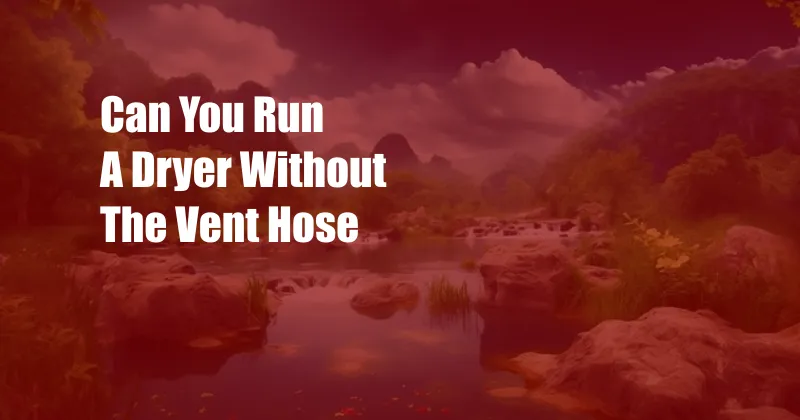
Can You Run a Dryer Without the Vent Hose?
In the laundry room’s depths, I recently stumbled upon a perplexing question: could I operate my fidèle dryer without the vent hose? The wretched vent had become a conduit for all manner of lint and debris, leaving me contemplating its necessity. Little did I know, this seemingly straightforward question would lead me down a labyrinthine path of dryer maintenance and efficiency.
Ventless Dryers: A Brief History and Overview
Ventless dryers, also known as condenser dryers, were conceived in the 1970s as a convenient alternative to traditional vented dryers. Unlike their vented counterparts, ventless dryers condense the moisture from clothes within a closed system, eliminating the need for external venting. This feature made them particularly appealing for apartments and homes with limited ventilation options.
How Ventless Dryers Work
Ventless dryers utilize a refrigeration system to extract moisture from clothes. Warm air is circulated through the clothes, evaporating the moisture. The evaporated moisture is then condensed into water, which is collected in a reservoir. The condensed water is either pumped out of the dryer through a drain hose or manually emptied.
The absence of a vent hose in ventless dryers offers several advantages. Firstly, it eliminates the need for external venting, making them suitable for installation in spaces where traditional vented dryers are impractical. Secondly, ventless dryers tend to be more energy-efficient than vented dryers, as they do not lose heated air through the vent hose.
Can You Run a Vented Dryer Without the Vent Hose?
The answer to this question is a resounding no. Vented dryers are designed to expel moisture through a vent hose, and operating them without the hose can have several detrimental consequences.
- Fire Hazard: The lint and debris that accumulate in the dryer’s exhaust system can ignite if the dryer is operated without the vent hose. This can lead to a house fire.
- Mold and Mildew Growth: The moisture that is normally expelled through the vent hose will condense inside the dryer without the hose. This moisture can promote the growth of mold and mildew, which can damage the dryer and cause health problems.
- Reduced Drying Efficiency: Without the vent hose, the dryer will not be able to effectively remove moisture from clothes. This will result in longer drying times and increased energy consumption.
Therefore, it is essential to ensure that your vented dryer is always operated with the vent hose properly connected and maintained. Bypassing the vent hose is not only dangerous but also detrimental to the dryer’s efficiency and lifespan.
Tips and Expert Advice for Maintaining Vented Dryers
- Clean the lint trap after every use: Lint accumulation is the primary cause of dryer fires. Regular cleaning of the lint trap helps prevent lint from entering the exhaust system.
- Inspect the vent hose regularly: Check the vent hose for kinks, tears, or blockages. A damaged or blocked vent hose can restrict airflow and reduce drying efficiency.
- Have the dryer professionally inspected and cleaned annually: A qualified technician can thoroughly inspect the dryer’s exhaust system and remove any accumulated lint or debris.
- Never use a dryer without the vent hose connected: Operating a vented dryer without the vent hose can have serious consequences, including fire, mold growth, and reduced drying efficiency.
By following these tips, you can help ensure that your vented dryer operates safely and efficiently for years to come.
Frequently Asked Questions (FAQs):
- Q: Why is it important to use the vent hose with a vented dryer?
- A: The vent hose is essential for expelling moisture and lint from the dryer. Operating the dryer without the vent hose can lead to fire hazards, mold growth, and reduced drying efficiency.
- Q: How often should I clean the lint trap?
- A: The lint trap should be cleaned after every use to prevent lint accumulation and potential fire hazards.
- Q: What are the signs of a blocked vent hose?
- A: Signs of a blocked vent hose include longer drying times, increased energy consumption, and a musty odor coming from the dryer.
- Q: Can I use a ventless dryer in any room?
- A: Ventless dryers can be used in most rooms, provided there is adequate ventilation to prevent moisture buildup. However, it is always best to consult the manufacturer’s instructions for specific installation requirements.
Conclusion
Operating a vented dryer without the vent hose is strongly discouraged due to the potential for fire hazards, mold growth, and reduced drying efficiency. By understanding the importance of proper dryer maintenance and following the tips and expert advice outlined in this article, you can ensure that your vented dryer operates safely and efficiently for many years to come. If you have any further questions or concerns about your dryer, it is always advisable to consult with a qualified appliance repair technician.
Are you interested in learning more about dryer maintenance and efficiency? Share your questions and comments in the section below, and I’ll be happy to assist you.